Risk Management Plan for 19735 Project 4 Blue Mountains TAFE
VerifiedAdded on 2023/04/23
|19
|2590
|104
AI Summary
This document outlines the risk management plan for 19735 Project 4 Blue Mountains TAFE, including procedures for risk identification, analysis, and assessment, as well as strategies for risk control and monitoring. The plan also includes a complete risk register with identified risks and their control strategies. The purpose of the plan is to ensure that potential risks to the project's delivery and outcomes are controlled in a timely and effective manner.
Contribute Materials
Your contribution can guide someone’s learning journey. Share your
documents today.
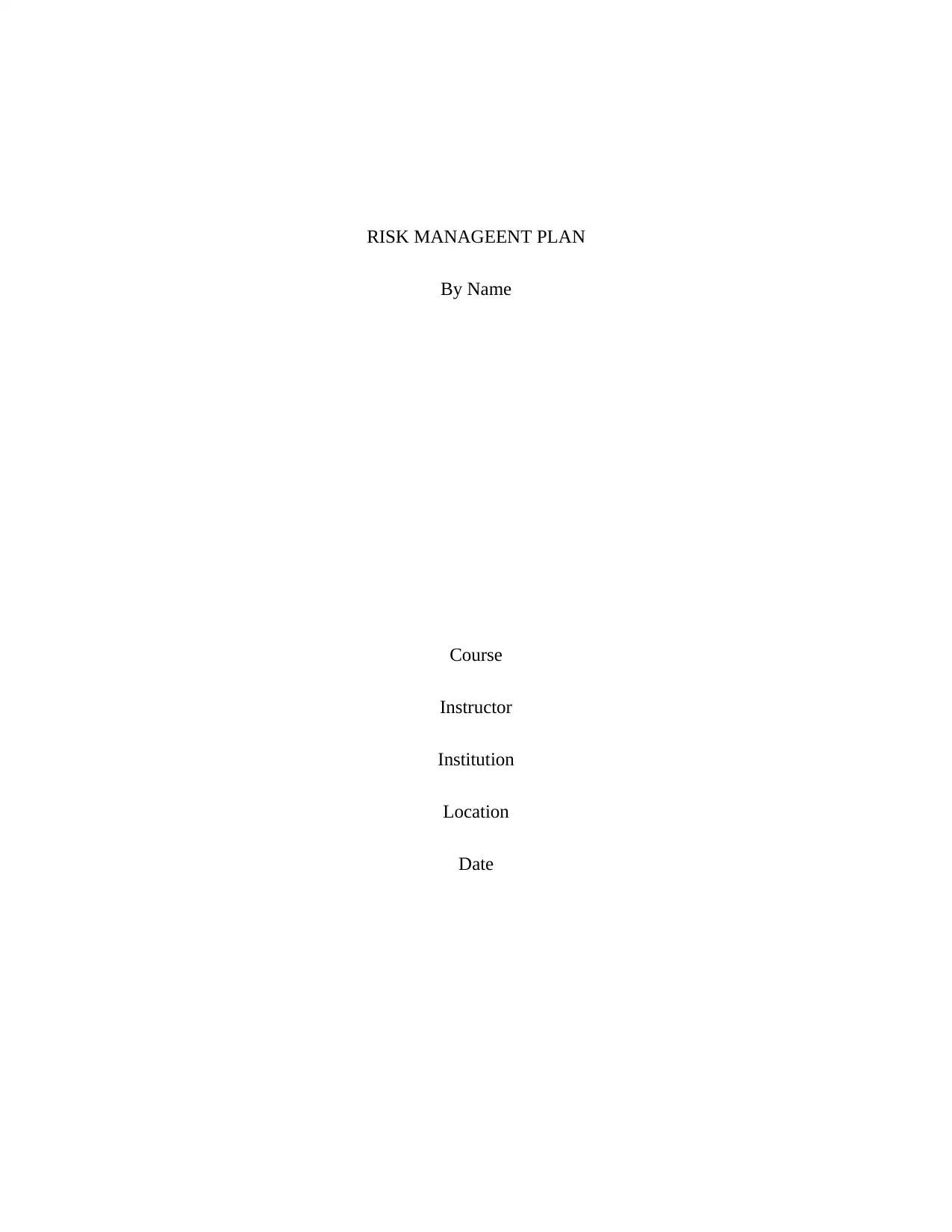
RISK MANAGEENT PLAN
By Name
Course
Instructor
Institution
Location
Date
By Name
Course
Instructor
Institution
Location
Date
Secure Best Marks with AI Grader
Need help grading? Try our AI Grader for instant feedback on your assignments.
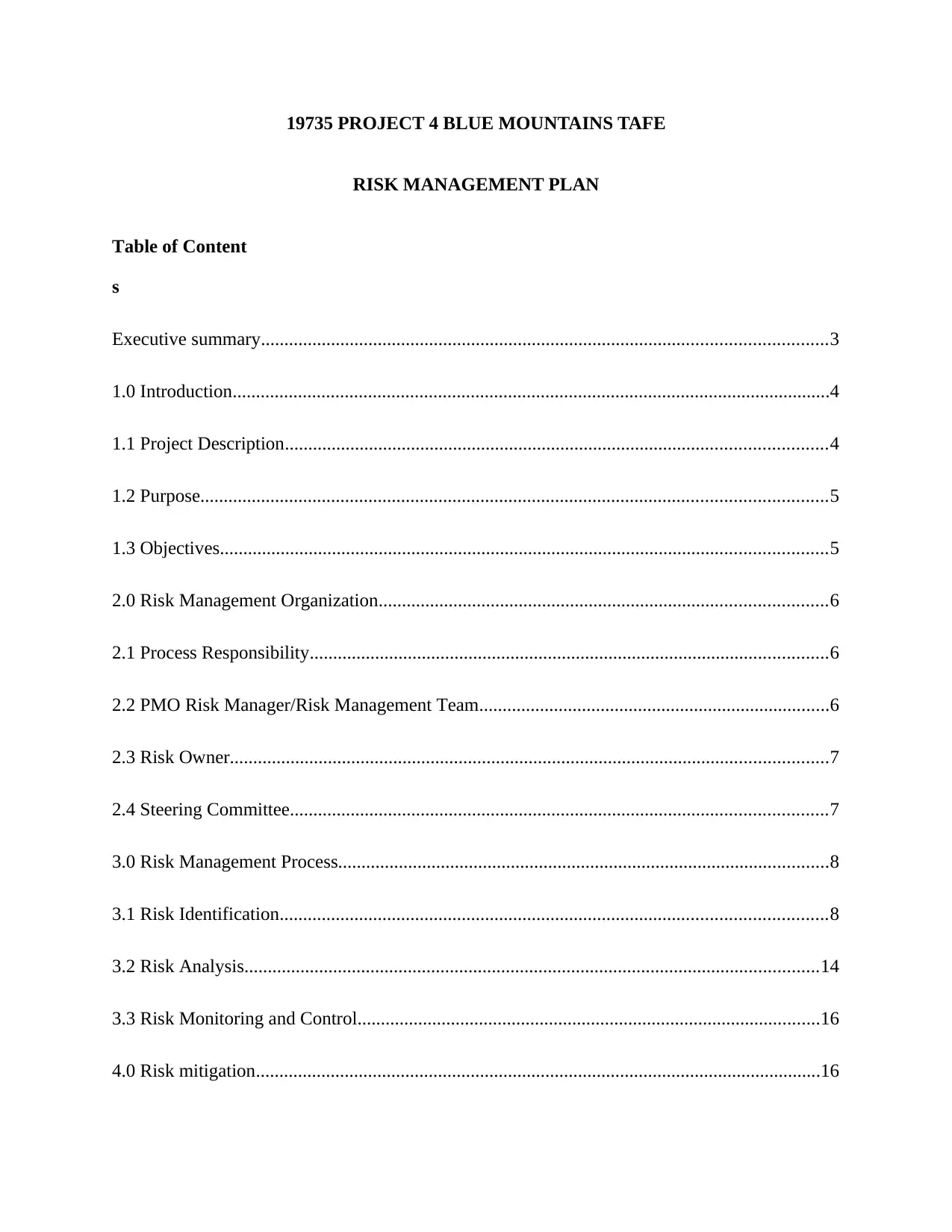
19735 PROJECT 4 BLUE MOUNTAINS TAFE
RISK MANAGEMENT PLAN
Table of Content
s
Executive summary.........................................................................................................................3
1.0 Introduction................................................................................................................................4
1.1 Project Description....................................................................................................................4
1.2 Purpose......................................................................................................................................5
1.3 Objectives..................................................................................................................................5
2.0 Risk Management Organization................................................................................................6
2.1 Process Responsibility...............................................................................................................6
2.2 PMO Risk Manager/Risk Management Team...........................................................................6
2.3 Risk Owner................................................................................................................................7
2.4 Steering Committee...................................................................................................................7
3.0 Risk Management Process.........................................................................................................8
3.1 Risk Identification.....................................................................................................................8
3.2 Risk Analysis...........................................................................................................................14
3.3 Risk Monitoring and Control...................................................................................................16
4.0 Risk mitigation.........................................................................................................................16
RISK MANAGEMENT PLAN
Table of Content
s
Executive summary.........................................................................................................................3
1.0 Introduction................................................................................................................................4
1.1 Project Description....................................................................................................................4
1.2 Purpose......................................................................................................................................5
1.3 Objectives..................................................................................................................................5
2.0 Risk Management Organization................................................................................................6
2.1 Process Responsibility...............................................................................................................6
2.2 PMO Risk Manager/Risk Management Team...........................................................................6
2.3 Risk Owner................................................................................................................................7
2.4 Steering Committee...................................................................................................................7
3.0 Risk Management Process.........................................................................................................8
3.1 Risk Identification.....................................................................................................................8
3.2 Risk Analysis...........................................................................................................................14
3.3 Risk Monitoring and Control...................................................................................................16
4.0 Risk mitigation.........................................................................................................................16
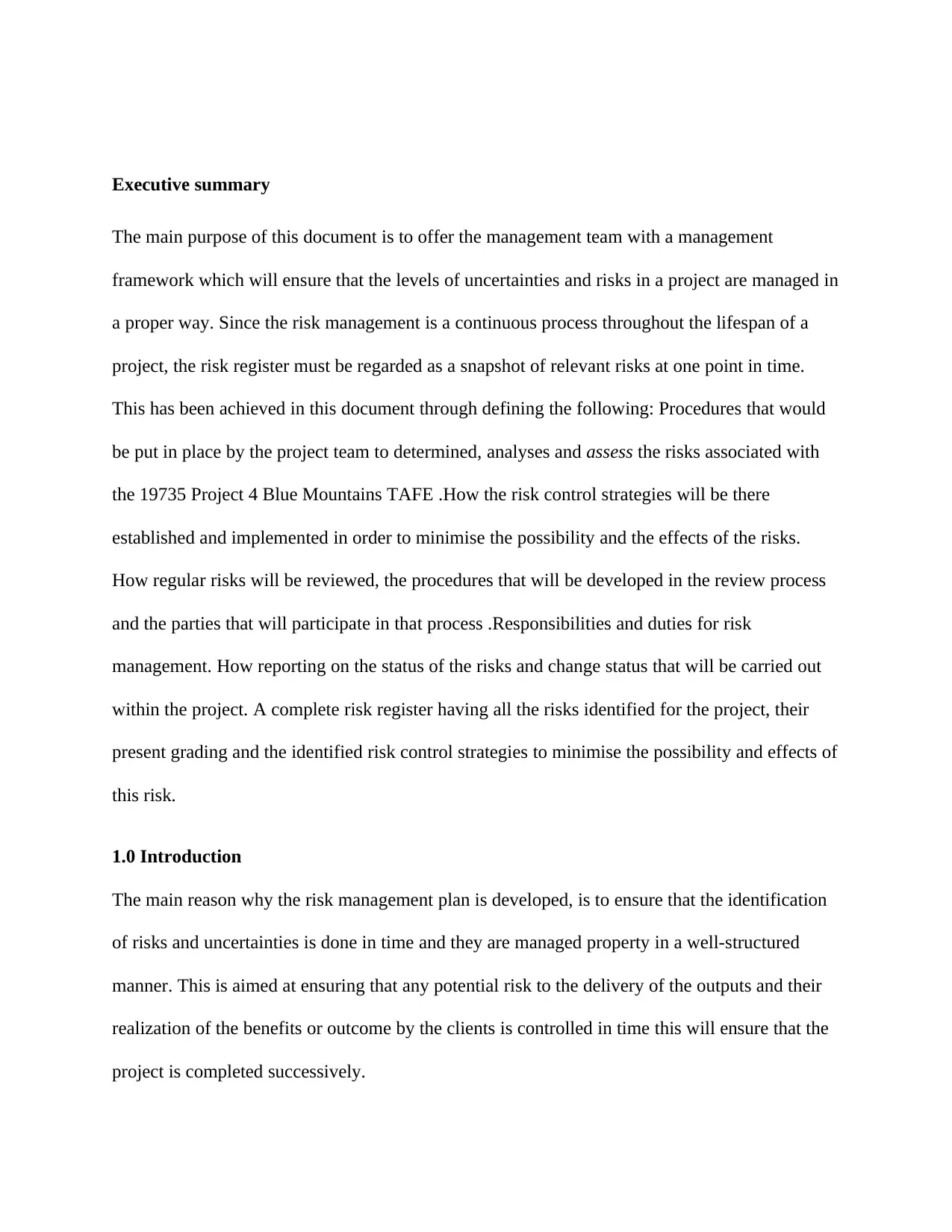
Executive summary
The main purpose of this document is to offer the management team with a management
framework which will ensure that the levels of uncertainties and risks in a project are managed in
a proper way. Since the risk management is a continuous process throughout the lifespan of a
project, the risk register must be regarded as a snapshot of relevant risks at one point in time.
This has been achieved in this document through defining the following: Procedures that would
be put in place by the project team to determined, analyses and assess the risks associated with
the 19735 Project 4 Blue Mountains TAFE .How the risk control strategies will be there
established and implemented in order to minimise the possibility and the effects of the risks.
How regular risks will be reviewed, the procedures that will be developed in the review process
and the parties that will participate in that process .Responsibilities and duties for risk
management. How reporting on the status of the risks and change status that will be carried out
within the project. A complete risk register having all the risks identified for the project, their
present grading and the identified risk control strategies to minimise the possibility and effects of
this risk.
1.0 Introduction
The main reason why the risk management plan is developed, is to ensure that the identification
of risks and uncertainties is done in time and they are managed property in a well-structured
manner. This is aimed at ensuring that any potential risk to the delivery of the outputs and their
realization of the benefits or outcome by the clients is controlled in time this will ensure that the
project is completed successively.
The main purpose of this document is to offer the management team with a management
framework which will ensure that the levels of uncertainties and risks in a project are managed in
a proper way. Since the risk management is a continuous process throughout the lifespan of a
project, the risk register must be regarded as a snapshot of relevant risks at one point in time.
This has been achieved in this document through defining the following: Procedures that would
be put in place by the project team to determined, analyses and assess the risks associated with
the 19735 Project 4 Blue Mountains TAFE .How the risk control strategies will be there
established and implemented in order to minimise the possibility and the effects of the risks.
How regular risks will be reviewed, the procedures that will be developed in the review process
and the parties that will participate in that process .Responsibilities and duties for risk
management. How reporting on the status of the risks and change status that will be carried out
within the project. A complete risk register having all the risks identified for the project, their
present grading and the identified risk control strategies to minimise the possibility and effects of
this risk.
1.0 Introduction
The main reason why the risk management plan is developed, is to ensure that the identification
of risks and uncertainties is done in time and they are managed property in a well-structured
manner. This is aimed at ensuring that any potential risk to the delivery of the outputs and their
realization of the benefits or outcome by the clients is controlled in time this will ensure that the
project is completed successively.
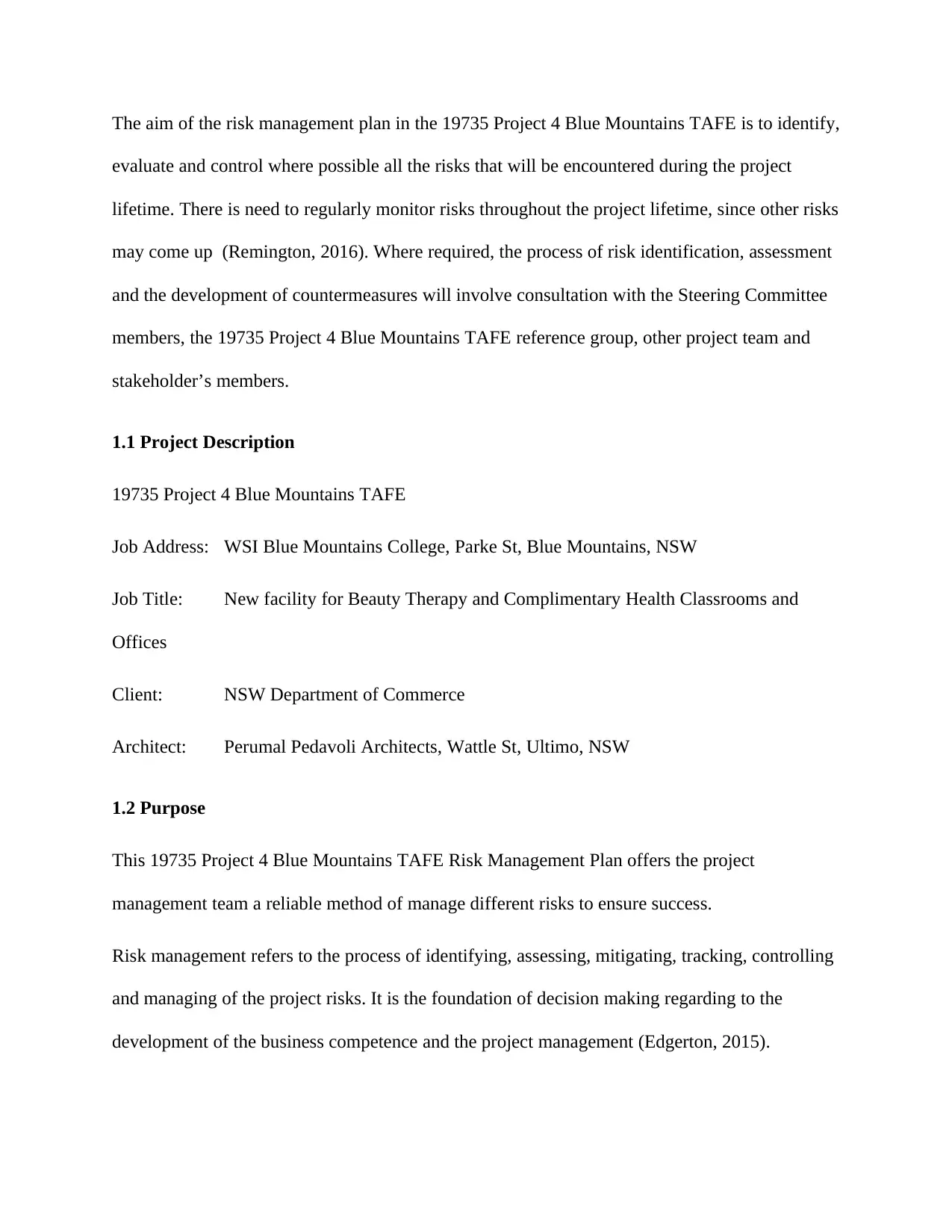
The aim of the risk management plan in the 19735 Project 4 Blue Mountains TAFE is to identify,
evaluate and control where possible all the risks that will be encountered during the project
lifetime. There is need to regularly monitor risks throughout the project lifetime, since other risks
may come up (Remington, 2016). Where required, the process of risk identification, assessment
and the development of countermeasures will involve consultation with the Steering Committee
members, the 19735 Project 4 Blue Mountains TAFE reference group, other project team and
stakeholder’s members.
1.1 Project Description
19735 Project 4 Blue Mountains TAFE
Job Address: WSI Blue Mountains College, Parke St, Blue Mountains, NSW
Job Title: New facility for Beauty Therapy and Complimentary Health Classrooms and
Offices
Client: NSW Department of Commerce
Architect: Perumal Pedavoli Architects, Wattle St, Ultimo, NSW
1.2 Purpose
This 19735 Project 4 Blue Mountains TAFE Risk Management Plan offers the project
management team a reliable method of manage different risks to ensure success.
Risk management refers to the process of identifying, assessing, mitigating, tracking, controlling
and managing of the project risks. It is the foundation of decision making regarding to the
development of the business competence and the project management (Edgerton, 2015).
evaluate and control where possible all the risks that will be encountered during the project
lifetime. There is need to regularly monitor risks throughout the project lifetime, since other risks
may come up (Remington, 2016). Where required, the process of risk identification, assessment
and the development of countermeasures will involve consultation with the Steering Committee
members, the 19735 Project 4 Blue Mountains TAFE reference group, other project team and
stakeholder’s members.
1.1 Project Description
19735 Project 4 Blue Mountains TAFE
Job Address: WSI Blue Mountains College, Parke St, Blue Mountains, NSW
Job Title: New facility for Beauty Therapy and Complimentary Health Classrooms and
Offices
Client: NSW Department of Commerce
Architect: Perumal Pedavoli Architects, Wattle St, Ultimo, NSW
1.2 Purpose
This 19735 Project 4 Blue Mountains TAFE Risk Management Plan offers the project
management team a reliable method of manage different risks to ensure success.
Risk management refers to the process of identifying, assessing, mitigating, tracking, controlling
and managing of the project risks. It is the foundation of decision making regarding to the
development of the business competence and the project management (Edgerton, 2015).
Secure Best Marks with AI Grader
Need help grading? Try our AI Grader for instant feedback on your assignments.
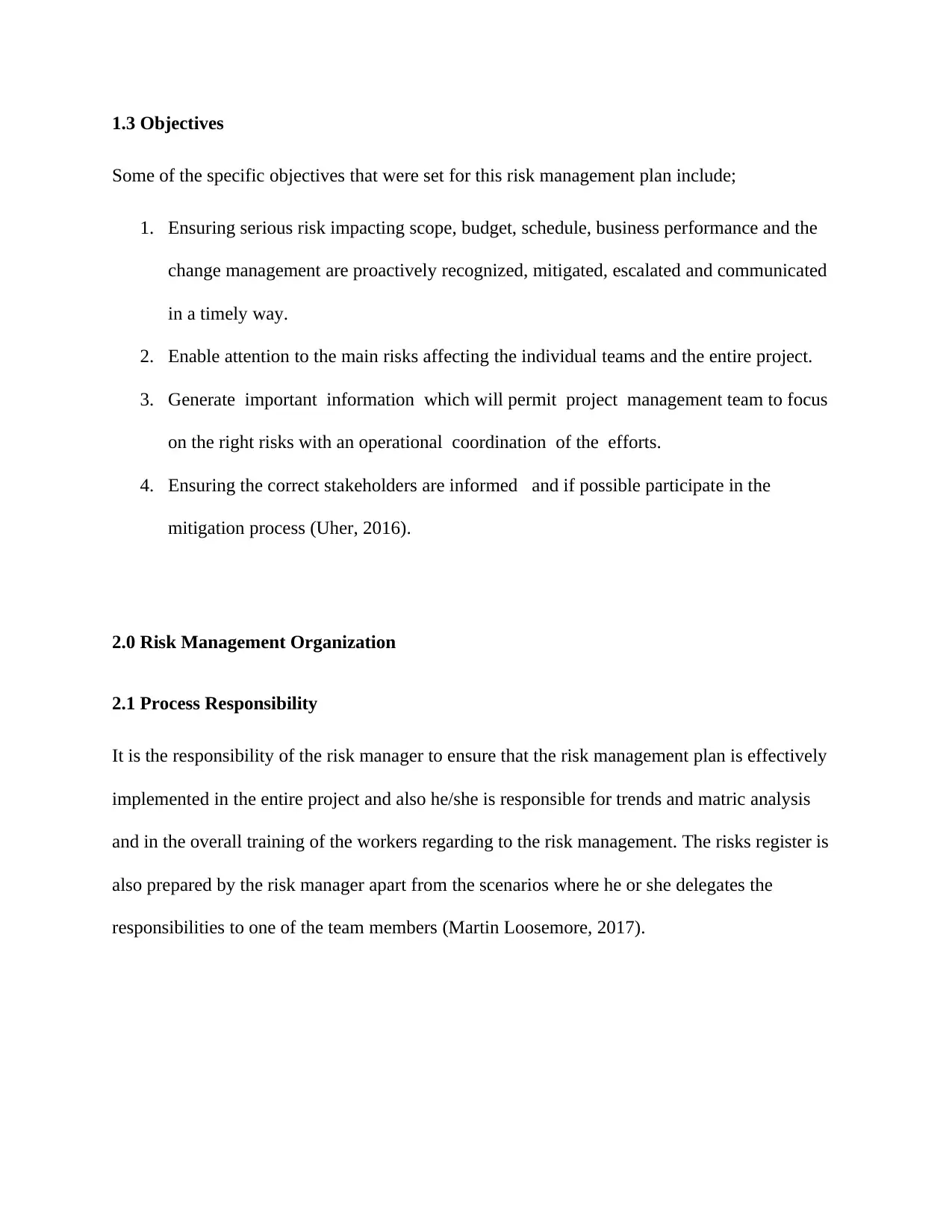
1.3 Objectives
Some of the specific objectives that were set for this risk management plan include;
1. Ensuring serious risk impacting scope, budget, schedule, business performance and the
change management are proactively recognized, mitigated, escalated and communicated
in a timely way.
2. Enable attention to the main risks affecting the individual teams and the entire project.
3. Generate important information which will permit project management team to focus
on the right risks with an operational coordination of the efforts.
4. Ensuring the correct stakeholders are informed and if possible participate in the
mitigation process (Uher, 2016).
2.0 Risk Management Organization
2.1 Process Responsibility
It is the responsibility of the risk manager to ensure that the risk management plan is effectively
implemented in the entire project and also he/she is responsible for trends and matric analysis
and in the overall training of the workers regarding to the risk management. The risks register is
also prepared by the risk manager apart from the scenarios where he or she delegates the
responsibilities to one of the team members (Martin Loosemore, 2017).
Some of the specific objectives that were set for this risk management plan include;
1. Ensuring serious risk impacting scope, budget, schedule, business performance and the
change management are proactively recognized, mitigated, escalated and communicated
in a timely way.
2. Enable attention to the main risks affecting the individual teams and the entire project.
3. Generate important information which will permit project management team to focus
on the right risks with an operational coordination of the efforts.
4. Ensuring the correct stakeholders are informed and if possible participate in the
mitigation process (Uher, 2016).
2.0 Risk Management Organization
2.1 Process Responsibility
It is the responsibility of the risk manager to ensure that the risk management plan is effectively
implemented in the entire project and also he/she is responsible for trends and matric analysis
and in the overall training of the workers regarding to the risk management. The risks register is
also prepared by the risk manager apart from the scenarios where he or she delegates the
responsibilities to one of the team members (Martin Loosemore, 2017).
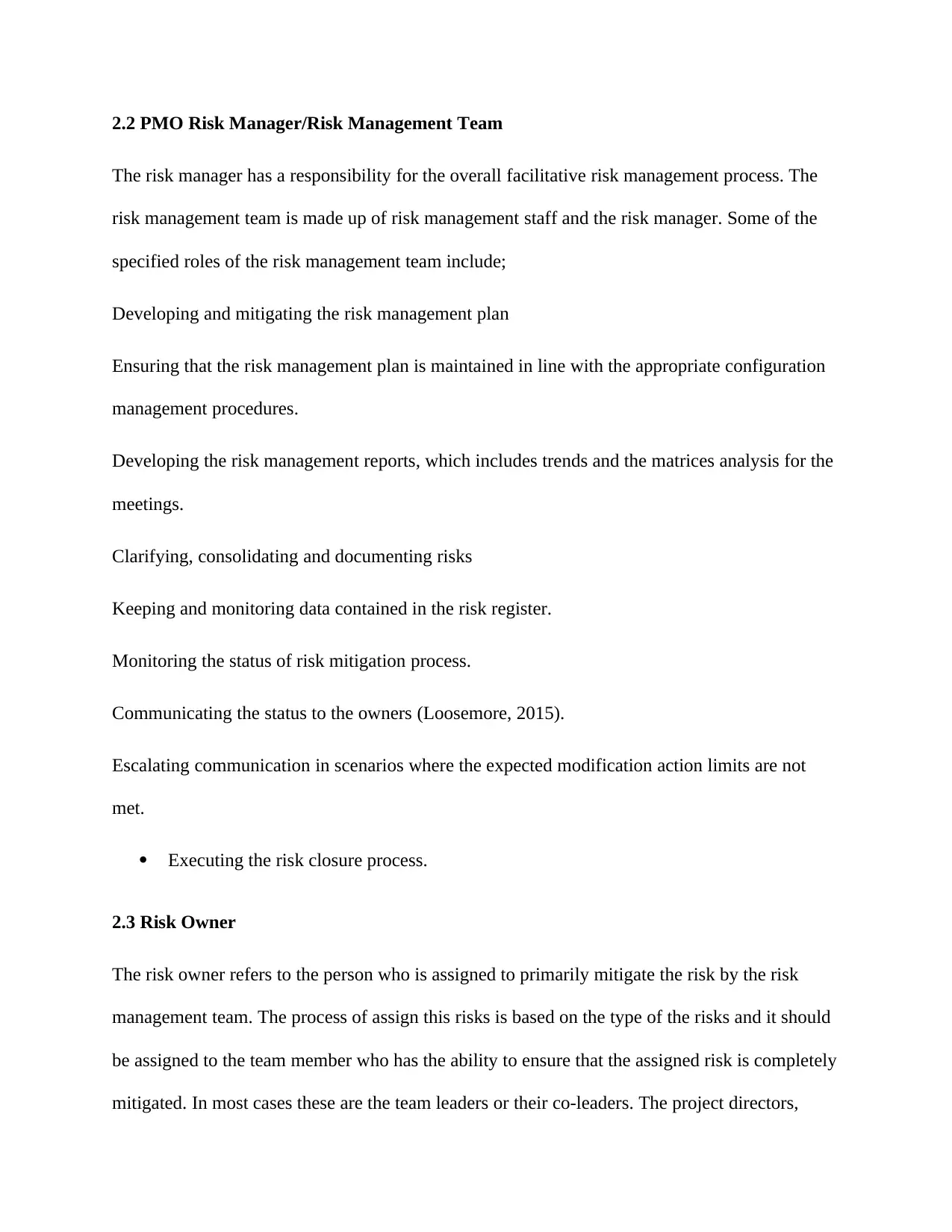
2.2 PMO Risk Manager/Risk Management Team
The risk manager has a responsibility for the overall facilitative risk management process. The
risk management team is made up of risk management staff and the risk manager. Some of the
specified roles of the risk management team include;
Developing and mitigating the risk management plan
Ensuring that the risk management plan is maintained in line with the appropriate configuration
management procedures.
Developing the risk management reports, which includes trends and the matrices analysis for the
meetings.
Clarifying, consolidating and documenting risks
Keeping and monitoring data contained in the risk register.
Monitoring the status of risk mitigation process.
Communicating the status to the owners (Loosemore, 2015).
Escalating communication in scenarios where the expected modification action limits are not
met.
Executing the risk closure process.
2.3 Risk Owner
The risk owner refers to the person who is assigned to primarily mitigate the risk by the risk
management team. The process of assign this risks is based on the type of the risks and it should
be assigned to the team member who has the ability to ensure that the assigned risk is completely
mitigated. In most cases these are the team leaders or their co-leaders. The project directors,
The risk manager has a responsibility for the overall facilitative risk management process. The
risk management team is made up of risk management staff and the risk manager. Some of the
specified roles of the risk management team include;
Developing and mitigating the risk management plan
Ensuring that the risk management plan is maintained in line with the appropriate configuration
management procedures.
Developing the risk management reports, which includes trends and the matrices analysis for the
meetings.
Clarifying, consolidating and documenting risks
Keeping and monitoring data contained in the risk register.
Monitoring the status of risk mitigation process.
Communicating the status to the owners (Loosemore, 2015).
Escalating communication in scenarios where the expected modification action limits are not
met.
Executing the risk closure process.
2.3 Risk Owner
The risk owner refers to the person who is assigned to primarily mitigate the risk by the risk
management team. The process of assign this risks is based on the type of the risks and it should
be assigned to the team member who has the ability to ensure that the assigned risk is completely
mitigated. In most cases these are the team leaders or their co-leaders. The project directors,

sponsors and managers may also need to be aligned with the risks in order to ensure that enough
support is given. Some of the roles and responsibilities of the risk owner include;
Assessing the risk and creating a risk mitigation plan which will meet the risk
management approval.
Mitigating the risk according to the risk mitigation plan
Recommending the risk closure to the risk management team (Cooper, 2014)
Presenting risk status at the risk management team meeting as needed.
2.4 Steering Committee
The steering committee has the role of ensuring the risk management plan is fully
executed .some of the specific roles of the steering committee include;
Approving the mitigation of the very high severity risks
Supporting the mitigation implementations
Assisting in the cross-organization and to include in determining the engagement of
the senior management and other organizational resources.
Communicating risks management status and all the risk responses.
Some of the activities involved in the risk control include;
Validating the risk mitigation plans and options.
Taking corrective action in the scenarios where the actual events occur.
Assessing impact on the project of actions taken (time, resources and cost).
Identifying new risks occurring as a result of from risk mitigation actions.
Ensuring the Project Plan is maintained.
support is given. Some of the roles and responsibilities of the risk owner include;
Assessing the risk and creating a risk mitigation plan which will meet the risk
management approval.
Mitigating the risk according to the risk mitigation plan
Recommending the risk closure to the risk management team (Cooper, 2014)
Presenting risk status at the risk management team meeting as needed.
2.4 Steering Committee
The steering committee has the role of ensuring the risk management plan is fully
executed .some of the specific roles of the steering committee include;
Approving the mitigation of the very high severity risks
Supporting the mitigation implementations
Assisting in the cross-organization and to include in determining the engagement of
the senior management and other organizational resources.
Communicating risks management status and all the risk responses.
Some of the activities involved in the risk control include;
Validating the risk mitigation plans and options.
Taking corrective action in the scenarios where the actual events occur.
Assessing impact on the project of actions taken (time, resources and cost).
Identifying new risks occurring as a result of from risk mitigation actions.
Ensuring the Project Plan is maintained.
Paraphrase This Document
Need a fresh take? Get an instant paraphrase of this document with our AI Paraphraser
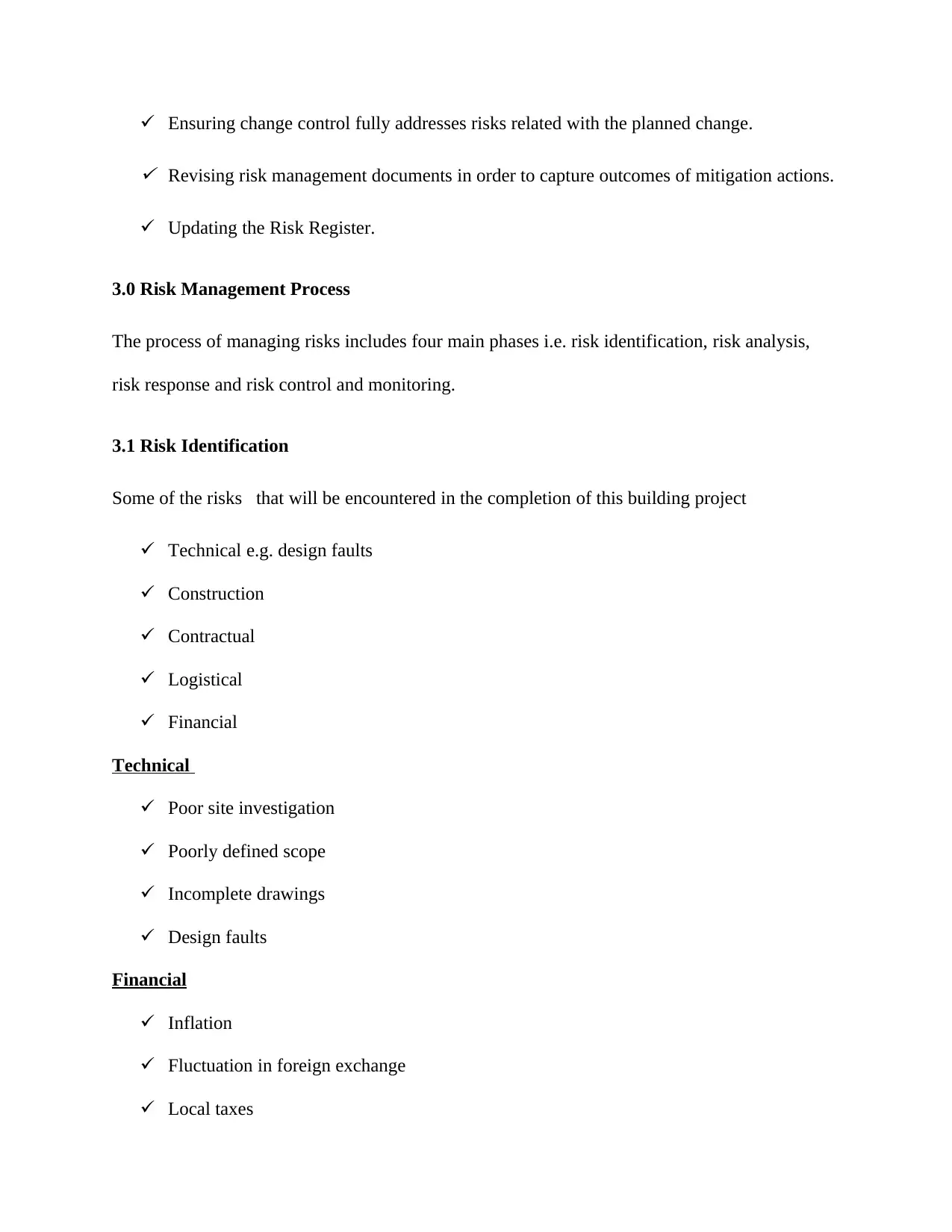
Ensuring change control fully addresses risks related with the planned change.
Revising risk management documents in order to capture outcomes of mitigation actions.
Updating the Risk Register.
3.0 Risk Management Process
The process of managing risks includes four main phases i.e. risk identification, risk analysis,
risk response and risk control and monitoring.
3.1 Risk Identification
Some of the risks that will be encountered in the completion of this building project
Technical e.g. design faults
Construction
Contractual
Logistical
Financial
Technical
Poor site investigation
Poorly defined scope
Incomplete drawings
Design faults
Financial
Inflation
Fluctuation in foreign exchange
Local taxes
Revising risk management documents in order to capture outcomes of mitigation actions.
Updating the Risk Register.
3.0 Risk Management Process
The process of managing risks includes four main phases i.e. risk identification, risk analysis,
risk response and risk control and monitoring.
3.1 Risk Identification
Some of the risks that will be encountered in the completion of this building project
Technical e.g. design faults
Construction
Contractual
Logistical
Financial
Technical
Poor site investigation
Poorly defined scope
Incomplete drawings
Design faults
Financial
Inflation
Fluctuation in foreign exchange
Local taxes

Availability of foreign exchange
Logical
Availability of transportation facilities
Damage of construction equipment
Availability of equipment such as spare parts, fuel, and labour
Construction risks
Unknown site conditions and hazards
Natural disasters such as earthquakes (Lingard, 2014)
Contractual
Poorly written contracts
Logical
Availability of transportation facilities
Damage of construction equipment
Availability of equipment such as spare parts, fuel, and labour
Construction risks
Unknown site conditions and hazards
Natural disasters such as earthquakes (Lingard, 2014)
Contractual
Poorly written contracts
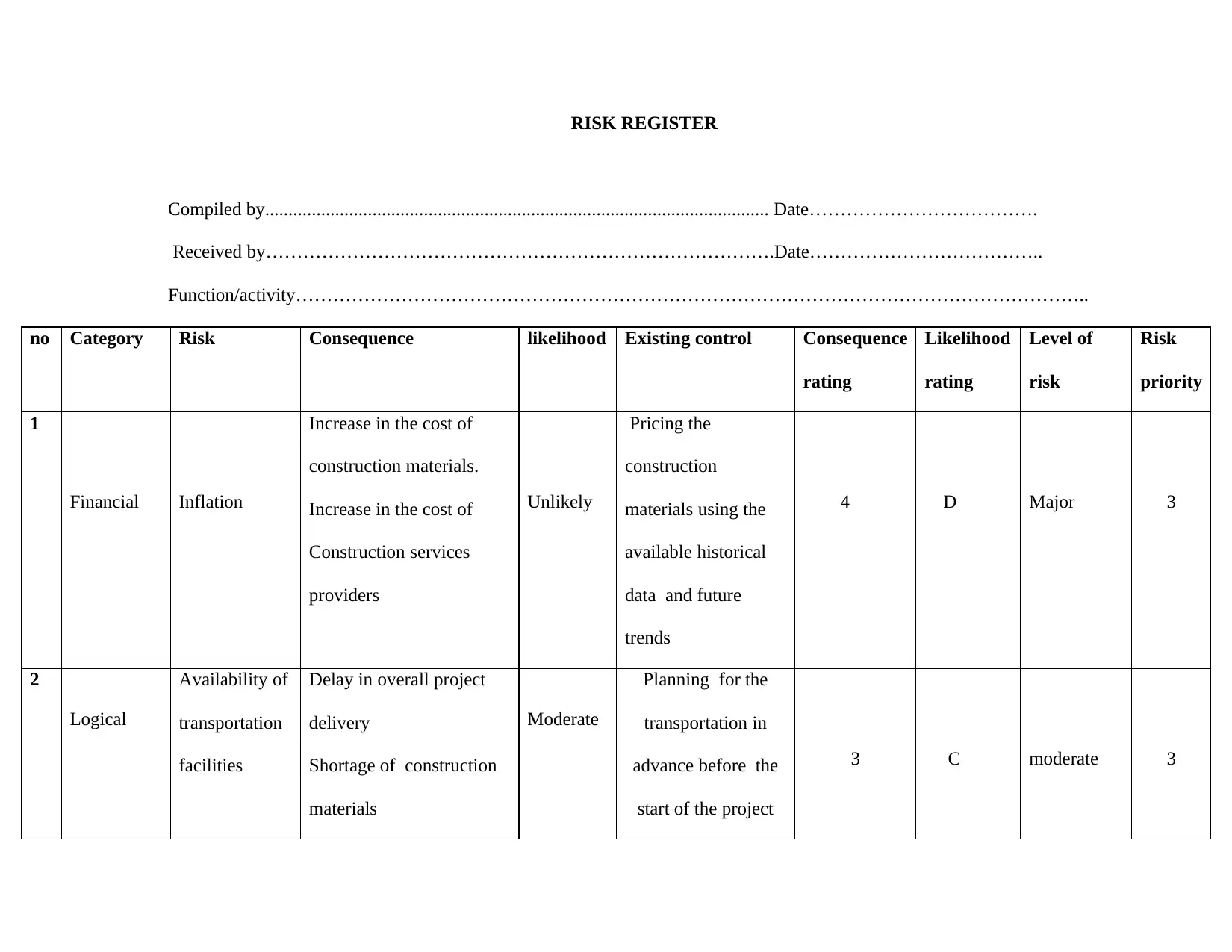
RISK REGISTER
Compiled by............................................................................................................ Date……………………………….
Received by……………………………………………………………………….Date………………………………..
Function/activity………………………………………………………………………………………………………………..
no Category Risk Consequence likelihood Existing control Consequence
rating
Likelihood
rating
Level of
risk
Risk
priority
1
Financial Inflation
Increase in the cost of
construction materials.
Increase in the cost of
Construction services
providers
Unlikely
Pricing the
construction
materials using the
available historical
data and future
trends
4 D Major 3
2
Logical
Availability of
transportation
facilities
Delay in overall project
delivery
Shortage of construction
materials
Moderate
Planning for the
transportation in
advance before the
start of the project
3 C moderate 3
Compiled by............................................................................................................ Date……………………………….
Received by……………………………………………………………………….Date………………………………..
Function/activity………………………………………………………………………………………………………………..
no Category Risk Consequence likelihood Existing control Consequence
rating
Likelihood
rating
Level of
risk
Risk
priority
1
Financial Inflation
Increase in the cost of
construction materials.
Increase in the cost of
Construction services
providers
Unlikely
Pricing the
construction
materials using the
available historical
data and future
trends
4 D Major 3
2
Logical
Availability of
transportation
facilities
Delay in overall project
delivery
Shortage of construction
materials
Moderate
Planning for the
transportation in
advance before the
start of the project
3 C moderate 3
Secure Best Marks with AI Grader
Need help grading? Try our AI Grader for instant feedback on your assignments.
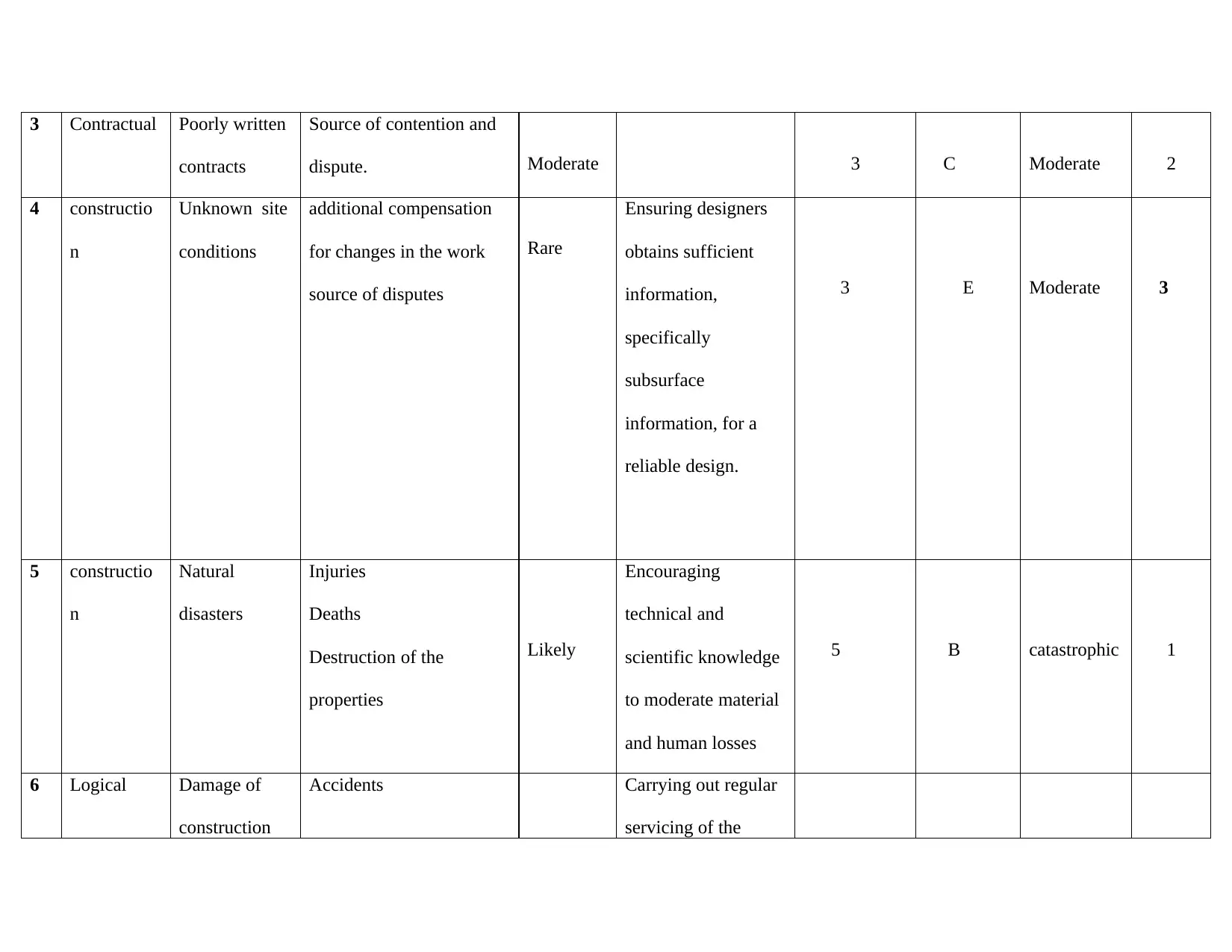
3 Contractual Poorly written
contracts
Source of contention and
dispute. Moderate 3 C Moderate 2
4 constructio
n
Unknown site
conditions
additional compensation
for changes in the work
source of disputes
Rare
Ensuring designers
obtains sufficient
information,
specifically
subsurface
information, for a
reliable design.
3 E Moderate 3
5 constructio
n
Natural
disasters
Injuries
Deaths
Destruction of the
properties
Likely
Encouraging
technical and
scientific knowledge
to moderate material
and human losses
5 B catastrophic 1
6 Logical Damage of
construction
Accidents Carrying out regular
servicing of the
contracts
Source of contention and
dispute. Moderate 3 C Moderate 2
4 constructio
n
Unknown site
conditions
additional compensation
for changes in the work
source of disputes
Rare
Ensuring designers
obtains sufficient
information,
specifically
subsurface
information, for a
reliable design.
3 E Moderate 3
5 constructio
n
Natural
disasters
Injuries
Deaths
Destruction of the
properties
Likely
Encouraging
technical and
scientific knowledge
to moderate material
and human losses
5 B catastrophic 1
6 Logical Damage of
construction
Accidents Carrying out regular
servicing of the
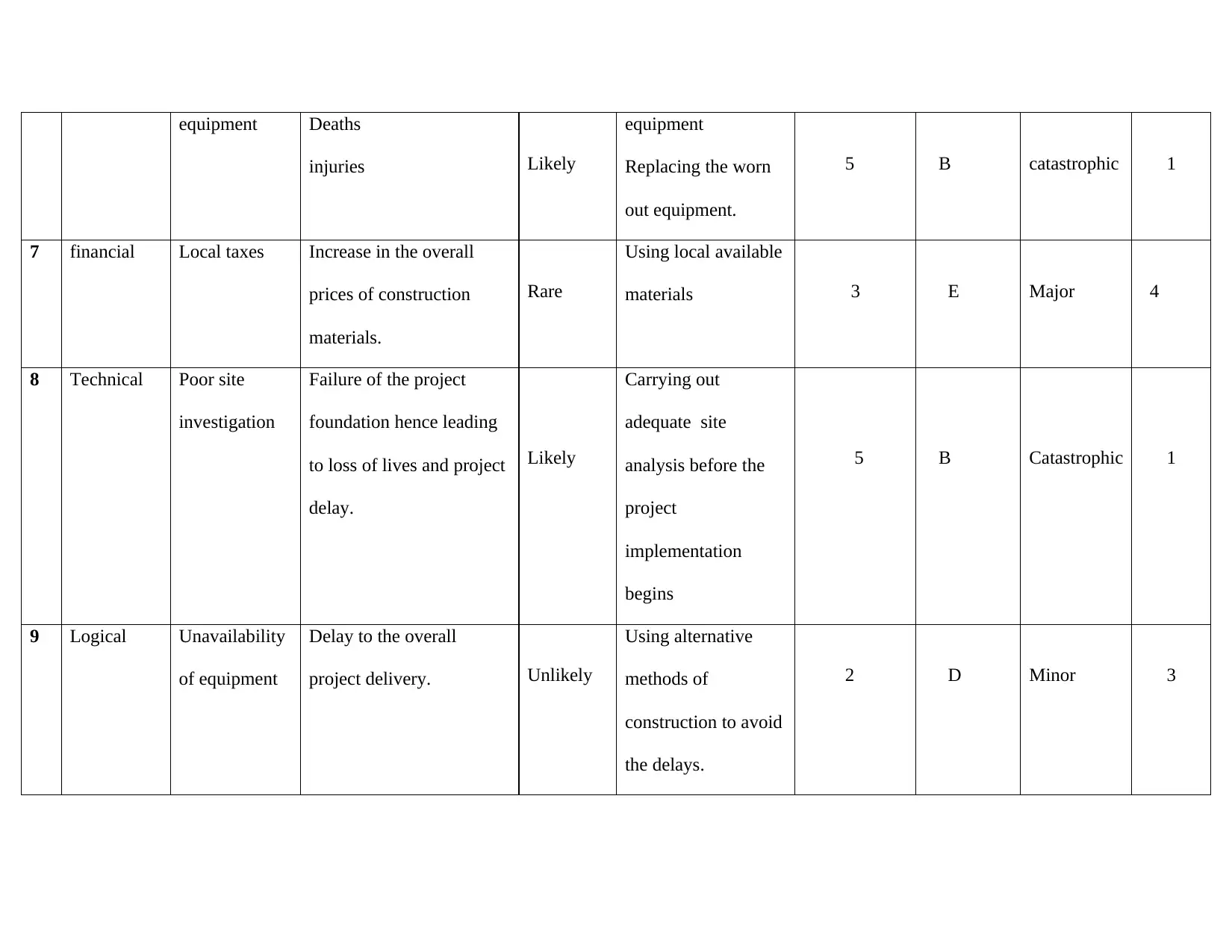
equipment Deaths
injuries Likely
equipment
Replacing the worn
out equipment.
5 B catastrophic 1
7 financial Local taxes Increase in the overall
prices of construction
materials.
Rare
Using local available
materials 3 E Major 4
8 Technical Poor site
investigation
Failure of the project
foundation hence leading
to loss of lives and project
delay.
Likely
Carrying out
adequate site
analysis before the
project
implementation
begins
5 B Catastrophic 1
9 Logical Unavailability
of equipment
Delay to the overall
project delivery. Unlikely
Using alternative
methods of
construction to avoid
the delays.
2 D Minor 3
injuries Likely
equipment
Replacing the worn
out equipment.
5 B catastrophic 1
7 financial Local taxes Increase in the overall
prices of construction
materials.
Rare
Using local available
materials 3 E Major 4
8 Technical Poor site
investigation
Failure of the project
foundation hence leading
to loss of lives and project
delay.
Likely
Carrying out
adequate site
analysis before the
project
implementation
begins
5 B Catastrophic 1
9 Logical Unavailability
of equipment
Delay to the overall
project delivery. Unlikely
Using alternative
methods of
construction to avoid
the delays.
2 D Minor 3

Paraphrase This Document
Need a fresh take? Get an instant paraphrase of this document with our AI Paraphraser
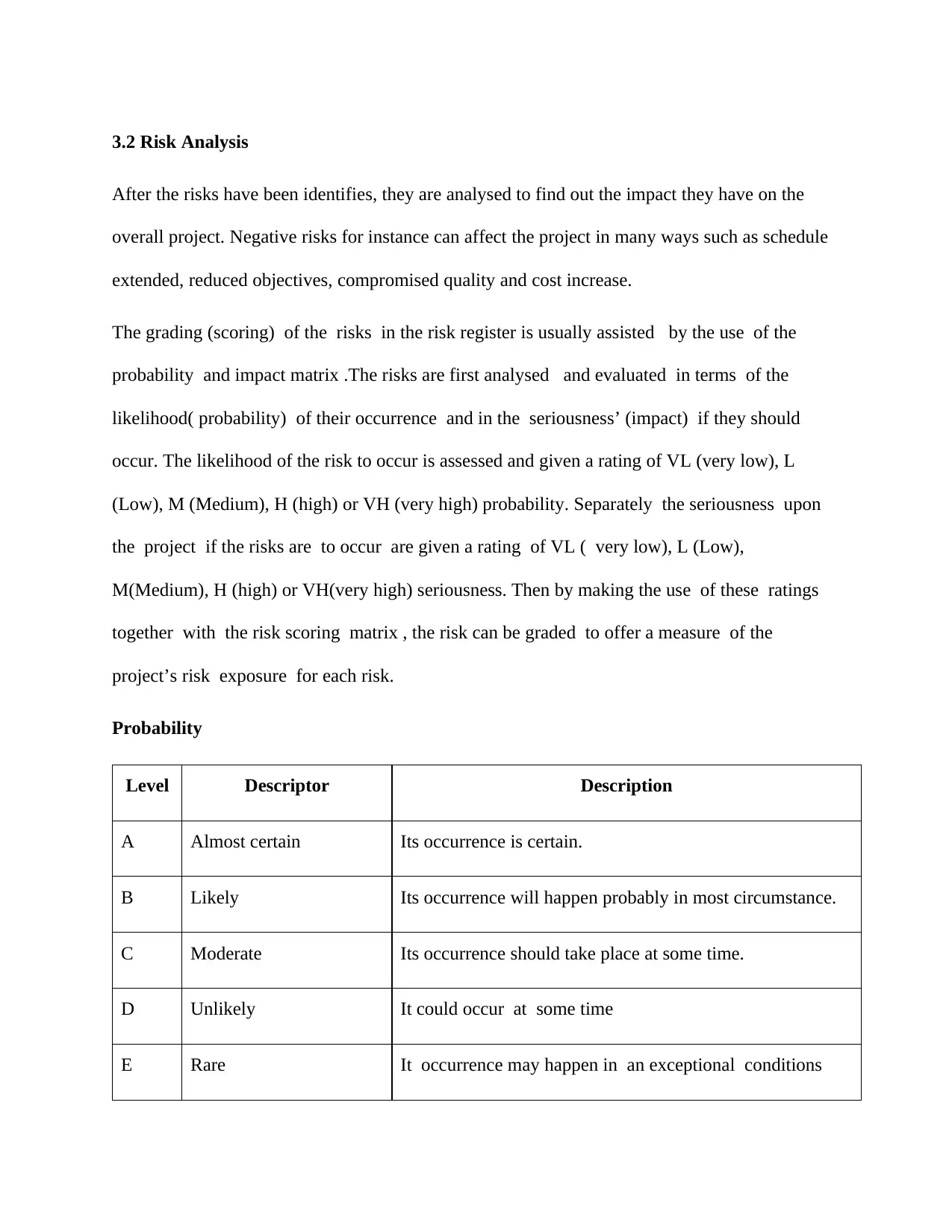
3.2 Risk Analysis
After the risks have been identifies, they are analysed to find out the impact they have on the
overall project. Negative risks for instance can affect the project in many ways such as schedule
extended, reduced objectives, compromised quality and cost increase.
The grading (scoring) of the risks in the risk register is usually assisted by the use of the
probability and impact matrix .The risks are first analysed and evaluated in terms of the
likelihood( probability) of their occurrence and in the seriousness’ (impact) if they should
occur. The likelihood of the risk to occur is assessed and given a rating of VL (very low), L
(Low), M (Medium), H (high) or VH (very high) probability. Separately the seriousness upon
the project if the risks are to occur are given a rating of VL ( very low), L (Low),
M(Medium), H (high) or VH(very high) seriousness. Then by making the use of these ratings
together with the risk scoring matrix , the risk can be graded to offer a measure of the
project’s risk exposure for each risk.
Probability
Level Descriptor Description
A Almost certain Its occurrence is certain.
B Likely Its occurrence will happen probably in most circumstance.
C Moderate Its occurrence should take place at some time.
D Unlikely It could occur at some time
E Rare It occurrence may happen in an exceptional conditions
After the risks have been identifies, they are analysed to find out the impact they have on the
overall project. Negative risks for instance can affect the project in many ways such as schedule
extended, reduced objectives, compromised quality and cost increase.
The grading (scoring) of the risks in the risk register is usually assisted by the use of the
probability and impact matrix .The risks are first analysed and evaluated in terms of the
likelihood( probability) of their occurrence and in the seriousness’ (impact) if they should
occur. The likelihood of the risk to occur is assessed and given a rating of VL (very low), L
(Low), M (Medium), H (high) or VH (very high) probability. Separately the seriousness upon
the project if the risks are to occur are given a rating of VL ( very low), L (Low),
M(Medium), H (high) or VH(very high) seriousness. Then by making the use of these ratings
together with the risk scoring matrix , the risk can be graded to offer a measure of the
project’s risk exposure for each risk.
Probability
Level Descriptor Description
A Almost certain Its occurrence is certain.
B Likely Its occurrence will happen probably in most circumstance.
C Moderate Its occurrence should take place at some time.
D Unlikely It could occur at some time
E Rare It occurrence may happen in an exceptional conditions
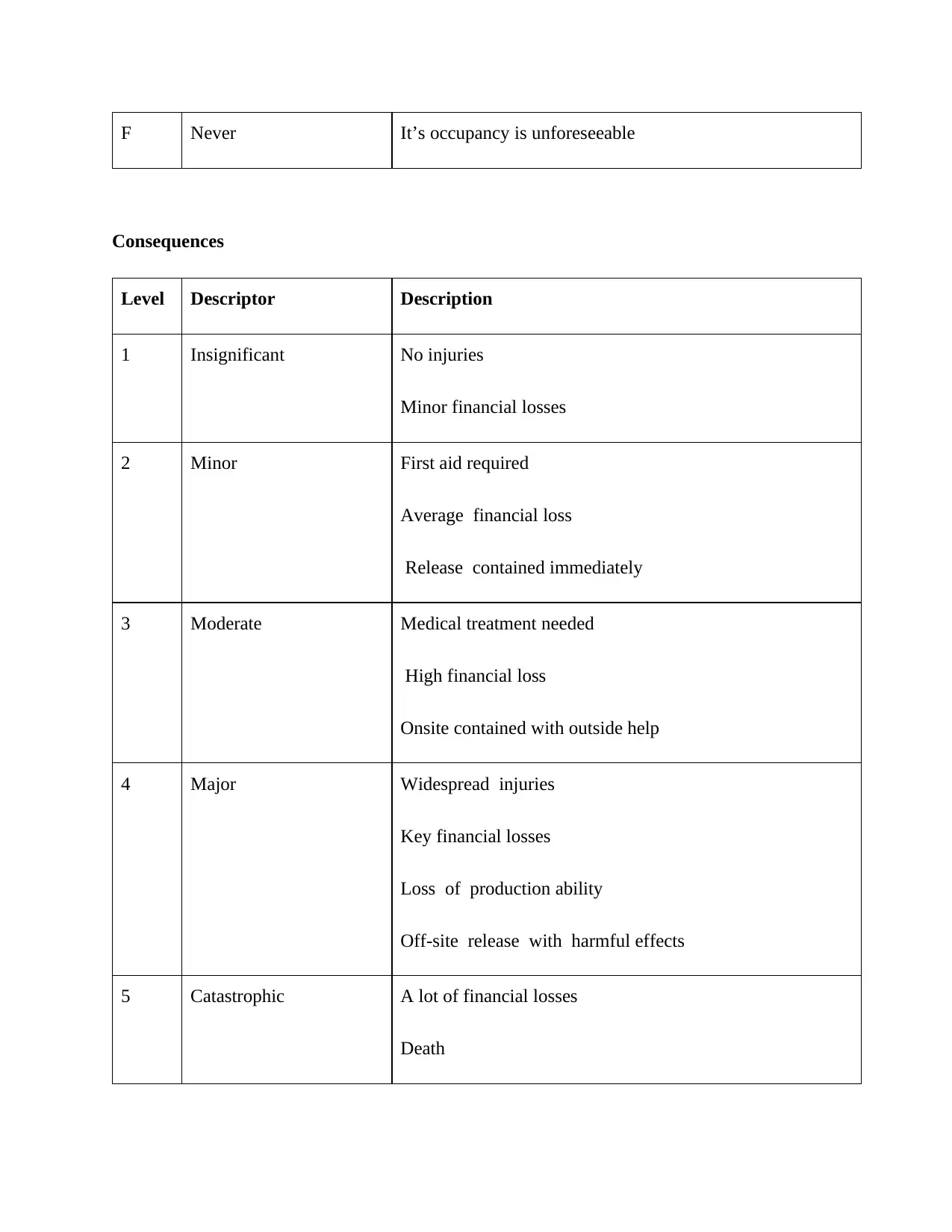
F Never It’s occupancy is unforeseeable
Consequences
Level Descriptor Description
1 Insignificant No injuries
Minor financial losses
2 Minor First aid required
Average financial loss
Release contained immediately
3 Moderate Medical treatment needed
High financial loss
Onsite contained with outside help
4 Major Widespread injuries
Key financial losses
Loss of production ability
Off-site release with harmful effects
5 Catastrophic A lot of financial losses
Death
Consequences
Level Descriptor Description
1 Insignificant No injuries
Minor financial losses
2 Minor First aid required
Average financial loss
Release contained immediately
3 Moderate Medical treatment needed
High financial loss
Onsite contained with outside help
4 Major Widespread injuries
Key financial losses
Loss of production ability
Off-site release with harmful effects
5 Catastrophic A lot of financial losses
Death
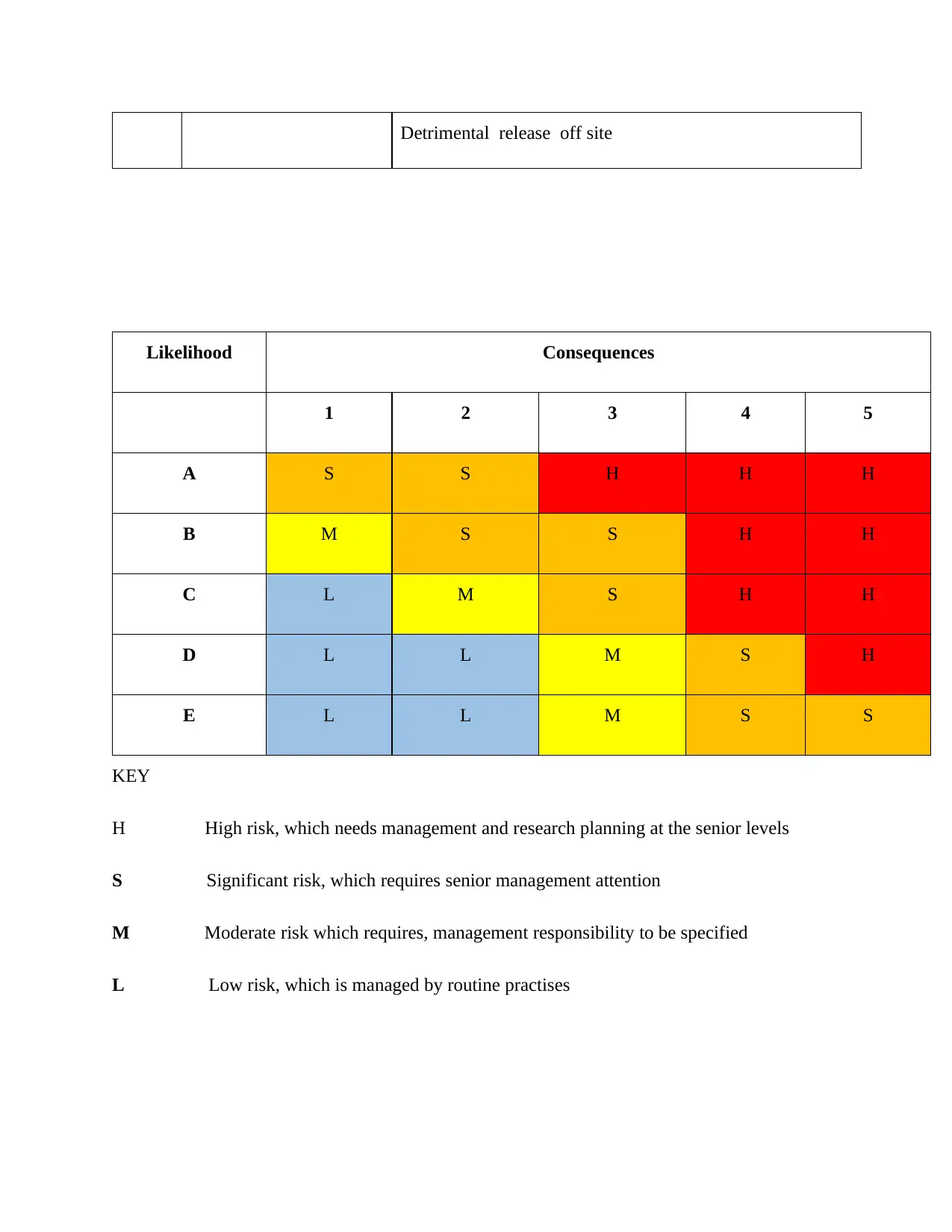
Detrimental release off site
Likelihood Consequences
1 2 3 4 5
A S S H H H
B M S S H H
C L M S H H
D L L M S H
E L L M S S
KEY
H High risk, which needs management and research planning at the senior levels
S Significant risk, which requires senior management attention
M Moderate risk which requires, management responsibility to be specified
L Low risk, which is managed by routine practises
Likelihood Consequences
1 2 3 4 5
A S S H H H
B M S S H H
C L M S H H
D L L M S H
E L L M S S
KEY
H High risk, which needs management and research planning at the senior levels
S Significant risk, which requires senior management attention
M Moderate risk which requires, management responsibility to be specified
L Low risk, which is managed by routine practises
Secure Best Marks with AI Grader
Need help grading? Try our AI Grader for instant feedback on your assignments.
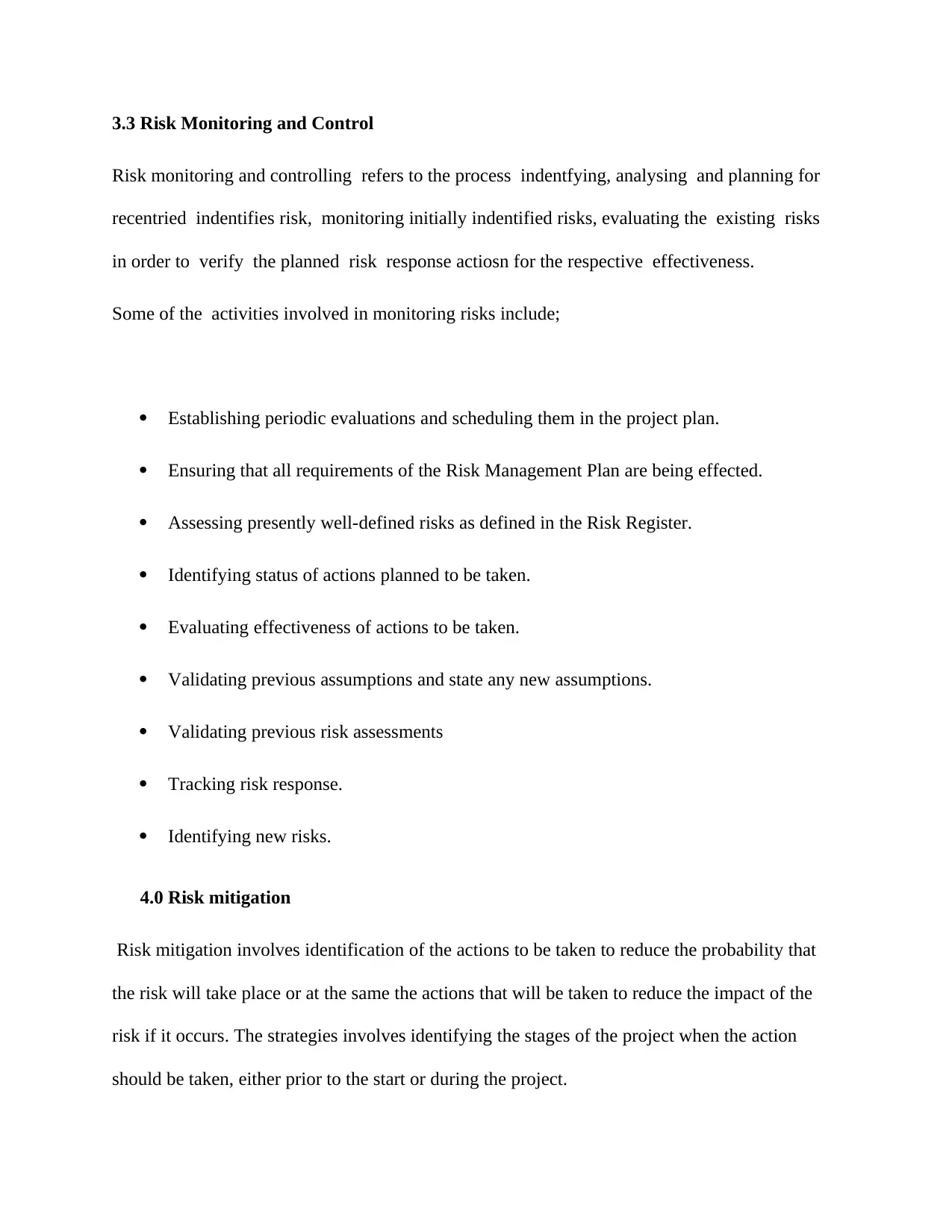
3.3 Risk Monitoring and Control
Risk monitoring and controlling refers to the process indentfying, analysing and planning for
recentried indentifies risk, monitoring initially indentified risks, evaluating the existing risks
in order to verify the planned risk response actiosn for the respective effectiveness.
Some of the activities involved in monitoring risks include;
Establishing periodic evaluations and scheduling them in the project plan.
Ensuring that all requirements of the Risk Management Plan are being effected.
Assessing presently well-defined risks as defined in the Risk Register.
Identifying status of actions planned to be taken.
Evaluating effectiveness of actions to be taken.
Validating previous assumptions and state any new assumptions.
Validating previous risk assessments
Tracking risk response.
Identifying new risks.
4.0 Risk mitigation
Risk mitigation involves identification of the actions to be taken to reduce the probability that
the risk will take place or at the same the actions that will be taken to reduce the impact of the
risk if it occurs. The strategies involves identifying the stages of the project when the action
should be taken, either prior to the start or during the project.
Risk monitoring and controlling refers to the process indentfying, analysing and planning for
recentried indentifies risk, monitoring initially indentified risks, evaluating the existing risks
in order to verify the planned risk response actiosn for the respective effectiveness.
Some of the activities involved in monitoring risks include;
Establishing periodic evaluations and scheduling them in the project plan.
Ensuring that all requirements of the Risk Management Plan are being effected.
Assessing presently well-defined risks as defined in the Risk Register.
Identifying status of actions planned to be taken.
Evaluating effectiveness of actions to be taken.
Validating previous assumptions and state any new assumptions.
Validating previous risk assessments
Tracking risk response.
Identifying new risks.
4.0 Risk mitigation
Risk mitigation involves identification of the actions to be taken to reduce the probability that
the risk will take place or at the same the actions that will be taken to reduce the impact of the
risk if it occurs. The strategies involves identifying the stages of the project when the action
should be taken, either prior to the start or during the project.

Risk mitigation strategies to minimise the chances that the risk will be realised and/or reduce the
seriousness of a risk if it is realised have been developed. The following table is useful to define
how risks will be treated in terms of preparation or deployment of mitigation plans during the life
of the Project.
seriousness of a risk if it is realised have been developed. The following table is useful to define
how risks will be treated in terms of preparation or deployment of mitigation plans during the life
of the Project.
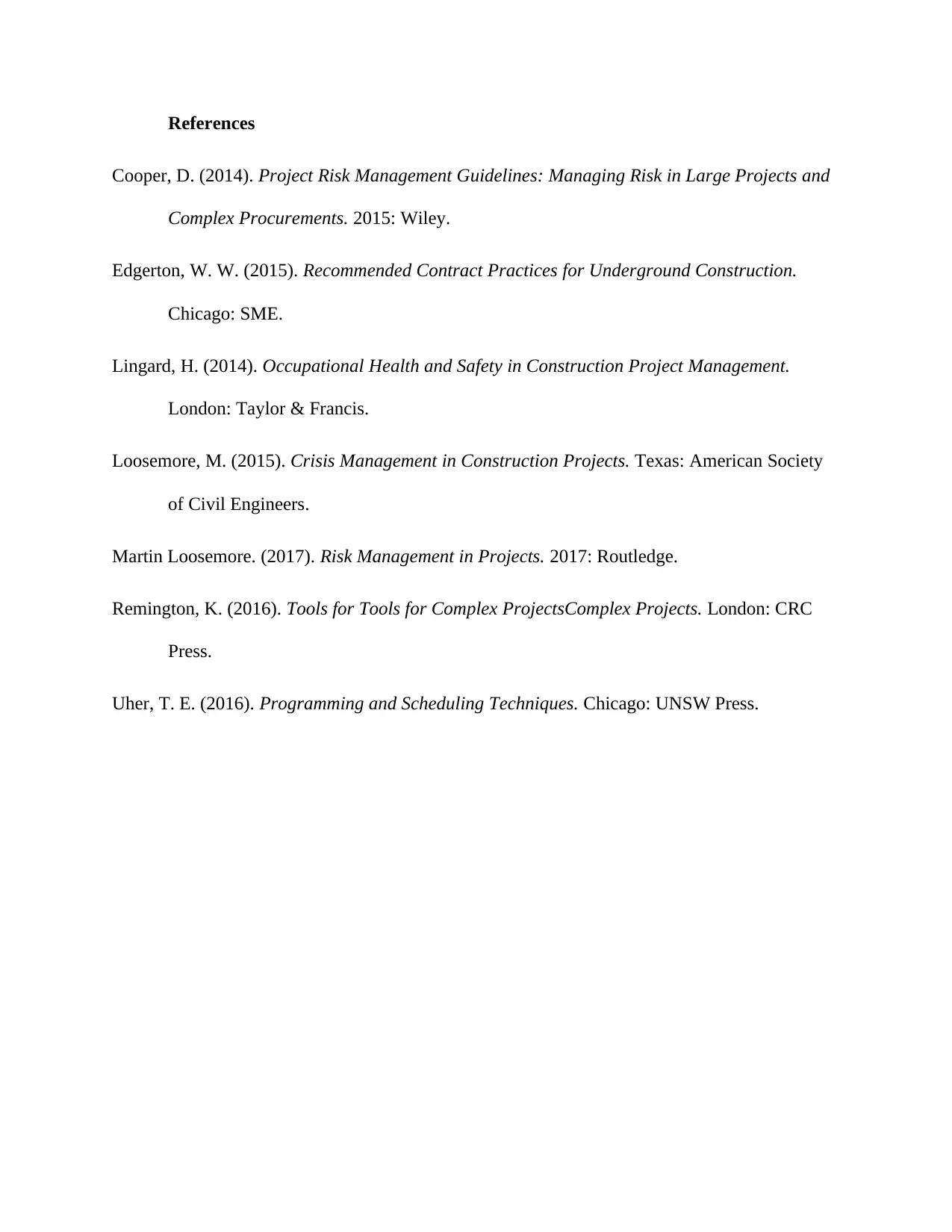
References
Cooper, D. (2014). Project Risk Management Guidelines: Managing Risk in Large Projects and
Complex Procurements. 2015: Wiley.
Edgerton, W. W. (2015). Recommended Contract Practices for Underground Construction.
Chicago: SME.
Lingard, H. (2014). Occupational Health and Safety in Construction Project Management.
London: Taylor & Francis.
Loosemore, M. (2015). Crisis Management in Construction Projects. Texas: American Society
of Civil Engineers.
Martin Loosemore. (2017). Risk Management in Projects. 2017: Routledge.
Remington, K. (2016). Tools for Tools for Complex ProjectsComplex Projects. London: CRC
Press.
Uher, T. E. (2016). Programming and Scheduling Techniques. Chicago: UNSW Press.
Cooper, D. (2014). Project Risk Management Guidelines: Managing Risk in Large Projects and
Complex Procurements. 2015: Wiley.
Edgerton, W. W. (2015). Recommended Contract Practices for Underground Construction.
Chicago: SME.
Lingard, H. (2014). Occupational Health and Safety in Construction Project Management.
London: Taylor & Francis.
Loosemore, M. (2015). Crisis Management in Construction Projects. Texas: American Society
of Civil Engineers.
Martin Loosemore. (2017). Risk Management in Projects. 2017: Routledge.
Remington, K. (2016). Tools for Tools for Complex ProjectsComplex Projects. London: CRC
Press.
Uher, T. E. (2016). Programming and Scheduling Techniques. Chicago: UNSW Press.
1 out of 19
Related Documents
Your All-in-One AI-Powered Toolkit for Academic Success.
+13062052269
info@desklib.com
Available 24*7 on WhatsApp / Email
![[object Object]](/_next/static/media/star-bottom.7253800d.svg)
Unlock your academic potential
© 2024 | Zucol Services PVT LTD | All rights reserved.





